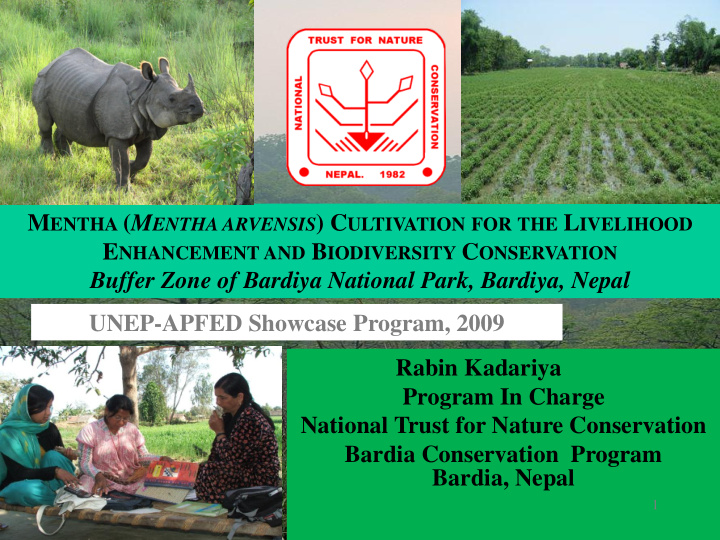



M ENTHA ( M ENTHA ARVENSIS ) C ULTIVATION FOR THE L IVELIHOOD E NHANCEMENT AND B IODIVERSITY C ONSERVATION Buffer Zone of Bardiya National Park, Bardiya, Nepal UNEP-APFED Showcase Program, 2009 Rabin Kadariya Program In Charge National Trust for Nature Conservation Bardia Conservation Program Bardia, Nepal 1
Project Summary • Project period: August 2009 - March 2011 • UNEP Garnt : 29,972 USD • Fund Leverage: • NTNC: 13,800 USD • Other: 45,867 USD (Local CBOs) • Project Implementation: NTNC and BNP • People benefited: Indigenous tharu people and hill migrants who live contiguous to park boundary • Project Location: Buffer zone of Bardia National Park 2
Project Location BARDIA NATIONAL PARK 3
What is Human Wildlife Conflict? • A rhino in farmer wheat field, an elephant trampling farmer house, or a leopard eating farmer's goat 4
Causes of HWC Increasing human settlement and livestock grazing in the traditional corridor of wildlife and near to the park boundary. local economy depend on subsistence agricultural farming especially cereal crops which are most preferred by wildlife Maize Paddy Wheat Lentil
Causes of HWC Contd........... Very poor economic condition Poor houses Open coral 6
Causes of HWC Contd........... People pressure inside the park Grass cutting and firewood collection Conflagration 7
Causes of HWC Contd........... Re-colonize population of Elephant and Translocation of Rhino 8
How severe is the problem in Bardia? 47% of winter wheat crops were damaged by wildlife in the area closest to the park boundary (Studsrod and Wegge, 1995 and Poudel, 2002) . 35.5% to 76% depending on proximity to park (Dahal,2001). Significantly higher losses of rice were recorded (83%) (Poudel, 2002). From 2000-2007, there were 1792 claims in BZMC.
Traditional Method (Human wildlife Conflict Mitigation) Chasing by producing loud noise and using fire torch leave the land fallow locally made watch tower Trench, Scarecrow and rope fence 10
Modern Approaches Cultivation of unpalatable crops (aromatic crops) Electric fencing Integrated approach 11
Objectives of Mentha Cultivation Project Exploring the solution for crop depredation by wildlife Mitigating human-wildlife conflicts Improving the economic condition of indigenous people and Awareness raising for the biodiversity conservation of national park by providing knowledge on its importance . 12
Project Activities 13
Conservation Education Session Community Outreach Eco club support Eco teacher workshop Jungle visit program 14
15
Major Aromatic Crops: Famer adopted Chamomile (Matricaria chamomilla) Mentha (Mentha arvensis) Selection of famer Cultivation training Seed/sucker support Establishment of DU Market of product 16 • Lemon grass and Citronella
Distillation Unit Types Simple mentha DU (USD 3700) Multipurpose DU (USD 23500 ) Medium Multipurpose DU (USD 10000 ) 17
Differences between the traditional crops and mentha • The average land holding in the area is less than 1 bigha (0.68 hectares). From 1 ha , a farmer can earn 1200 USD if they plant mentha, compared to about 400 USD from wheat and only 200 USD from maize • Individual farmers earn additional income which ranges 70 USD to 1000 USD depending upon land availability, in an average 190 USD per farmer, only in four month and paddy can be grown in rainy season which maintain the food security with additional income in the poor houses. • No damage to mentha from wildlife whereas severe damage of wheat and maize by rhino and elephants • farmers have a positive attitude towards wildlife conservation as the mentha is not raided by wildlife 18
Minimization of crop raiding 2009 2011 2010 2012 19
Is Mentha cultivation is sustainable and replicable ? Famers are having to keep mentha sucker in their farmland Cooperative arrange for the marketing of products Famers of non project areas of BNP and other protected areas 20 are also adopting the crop
Learning Alternative crops are the major scio-enviormental approach for human wildlife conflict around the habitat of wildlife Problem solution initiative is highly accepted by the community Local communities are involved in wildlife conservation if the conflicts are avoided. Any initiatives should have cash value and high economic benefit. 21
Opportunities in the South Asia • It can be replicated in the HWC prone area of South Area region (tropical and subtropical region) for the active involvement local communities in the conservation of large mammals such as rhino and elephant and other herbivores HOW? • Media ( newspaper, TV, Poster, internet, Facebook, Journal ) • Conference/Workshop 22
23
ID 2 ID 1 ID 3 & 4 ID 5 Thute Mau & Khagchiruwa Tikhe Terrible Thito Linde Bhale its Calf ID 8 & 9 ID 10 & 13 ID 6 ID 7 Raun Kane Pothi Tikhe Mau & its KCT’s Calf V-Kane Bhale & its Calf Calf ID 16 & 17 ID 11 ID 12 ID 14 & 15 Kan Katuwa Ghaite Gainda Golaghat Bhale Pothi & its Calf Gori Pothi & its Calf ID 18 ID 19 ID 20 Khag Tutali Pothi 24 Nikunja Bhale V-Kane Bhale-B
Please Let Us Live Together !!! 25
Recommend
More recommend